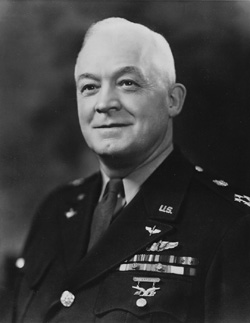Operation Bolero facts for kids
Operation Bolero was a secret plan during World War II. It was the code name for the huge movement of American soldiers and supplies to the United Kingdom. This buildup was in preparation for a big invasion plan called Operation Roundup. This invasion was meant to happen in mid-1943. There was also a smaller backup plan called Operation Sledgehammer for late 1942. These plans aimed to invade Europe from the UK. "Bolero" was also a code word used in official messages to mean "United Kingdom."
The idea for Operation Bolero started on April 12, 1942. General Henry H. Arnold, who led the U.S. Army Air Forces, suggested it to General George Marshall. Marshall was the top general of the U.S. Army. This plan started a massive movement of people and equipment. It set the stage for the even bigger Operation Overlord later in the war.
Contents
Getting Ready for the Invasion
To help with the Roundup invasion plan, work began in April 1942. This work focused on moving and housing U.S. forces in the United Kingdom. This effort was given the code name Bolero. A special group of British and American officers worked together. They planned this huge effort from both Washington, D.C. and London.
On May 5, 1942, General George Marshall and Lieutenant General Brehon B. Somervell chose Major General John C. H. Lee to lead the supply efforts. Lee spent two weeks in Washington planning. Then he flew to England to start the operation. His job was to build hundreds of bases, airfields, warehouses, hospitals, and storage tanks. These facilities would support the 3 million U.S. military personnel expected to arrive.
Air Force Plans
In May 1942, the U.S. War Department and Air Force Headquarters made plans. They aimed to transport and house one million American troops by April 1943. This included soldiers for the ground, air force, and supply services. General Arnold's plan called for many air force groups to be in the UK by April 1, 1943.
These groups included different types of bombers and fighter planes. For example, there were B-17 and B-24 heavy bombers. There were also P-38, P-39, P-40, and P-47 fighter planes. In total, 69 combat groups were planned. This was a huge number of planes and airmen.
General Arnold met with RAF Air Chief Marshal Charles Portal in May 1942. Arnold shared the U.S. schedule for air force arrivals. By March 1943, they expected to have 3,649 aircraft. The plan was to have 15 groups by July, 35 by November, and 66 by March. By April 1943, the Eighth Air Force was expected to have 800 heavy bombers and 960 fighters. At that time, the Eighth Air Force in the UK only had 1,871 troops and no aircraft.
Moving Air Groups
The movement of air combat groups started in May 1942. Their ground crews were sent by fast troopships. These were often former ocean liners. The planes themselves started moving in June. It was decided that the fastest way to build up the air force was for the groups to fly their own planes overseas.
Fighter planes only had one pilot. They also lacked proper navigation and communication equipment for long flights. So, they flew in groups of four. Bombers would fly with them to help with navigation.
Three groups were chosen for the first phase:
- The 97th Bomb Group (flying B-17s)
- The 1st Fighter Group (flying P-38s)
- The 60th Troop Carrier Group (flying C-47s)
These groups gathered on the east coast of the U.S. They prepared for their flights across the northern ferry route. Interestingly, these groups were originally meant for the Eighth Air Force. But they ended up serving mostly with the Twelfth Air Force in Africa.
The planners expected to lose about 10% of the planes during the first flights. But the actual loss rate was much lower, at 5.2%. The biggest loss happened on July 15, 1942. Six P-38s and two B-17s were flying from Greenland to Iceland. Bad weather forced them to try to return to Greenland. They ran out of fuel and had to land on the Greenland ice cap. The planes were left behind, but all the crews were rescued safely. One of the P-38s, called Glacier Girl, was found under the ice in 1992. It has since been restored and can fly again!
By the end of August 1942, Operation Bolero had moved 386 airplanes. These included P-38s, B-17s, and C-47s. Most of these planes became part of the Twelfth Air Force in Africa later that year. By the end of 1942, 920 planes had been sent from the U.S. to England. 882 arrived safely. Most of them were flown by their combat crews, not special ferry pilots.
Changes to Bolero
By July 1, 1942, other war needs caused changes to the Bolero plan. The number of groups was reduced to 54, with 194,332 men. Later that month, the U.S. Army Air Force estimated that by December 31, 1943, Bolero could have 137 groups in place. This included 74 bomb groups and 31 fighter groups. They estimated 375,000 airmen would be part of this force. This estimate turned out to be very close to the actual strength of the Eighth Air Force and Ninth Air Force during Operation Overlord.
In London, the Bolero Committee planned for 1,147,000 troops to be in the United Kingdom by March 1943. But by the end of July, the Sledgehammer plan was canceled. The Roundup plan was also put off until 1944. Instead, the focus shifted to Operation Torch. This was an invasion of North Africa. The goal was to create a base there to invade Southern Europe. So, the Bolero committee's work became helping with the Torch planning. The plans for the invasion of Europe were later handled by the Overlord planners.
Sources and Links
- The Army Air Forces in World War II online
- Orders to 1st FG for Bolero movement


